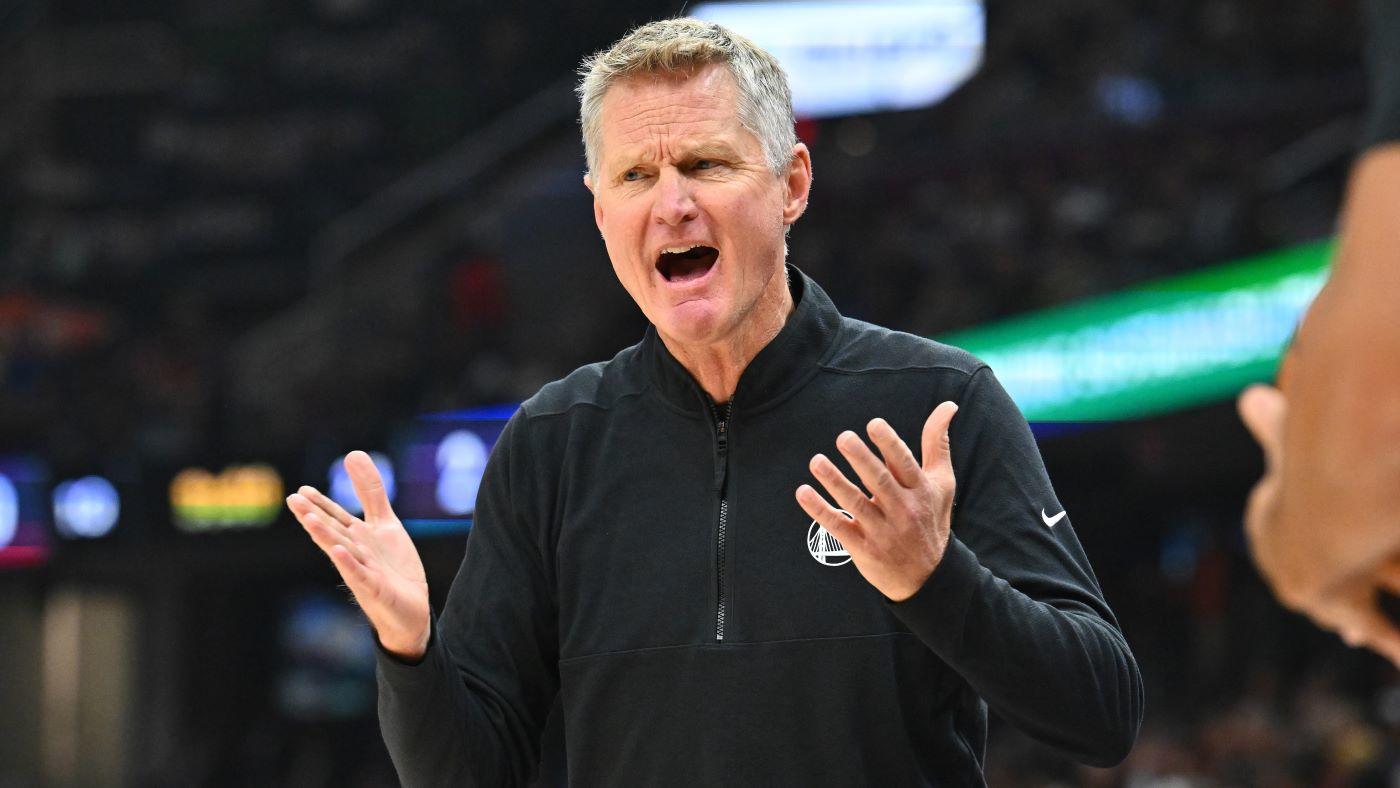
Golden State Warriors coach Steve Kerr thinks the 82-game NBA schedule is too demanding because the way basketball is played nowadays, and this has led to injuries. In an interview on KNBR during longtime host (and former Warrior) Tom Tolbert’s farewell show on Thursday, Kerr gave a clear-eyed explanation of why, despite advances in technology and increased focus on diet, sleep and training, so many players continue to get hurt.
“I think guys are playing faster and harder than ever before,” Kerr said. “If you turn on a game from the ’80s, turn on a Lakers-Celtics Finals game, first of all you pick up the guy at the top of the key, you don’t pick him up at halfcourt. You rarely ever have to run beyond the 3-point line to challenge the shot. We’re playing faster these days. The pace is up. I think guys are having to cover so much ground defensively, and we’re asking them to play harder and harder, night after night.
“And I know a lot of the old guys just don’t really buy that. But the old days, the game was inside-out, it was dump it into the post. There was no verticality — remember in the old days, you just took a charge. There was no charge circle, so if somebody was running in there, you just took a charge. Now, because of the charge circle, you have the Chet Holmgren play so you have to jump up. So the game is played more in the air defensively and there’s more likelihood that somebody comes down on an ankle or a hip, like Chet did.”
The Holmgren play in question occurred when the Warriors visited the Oklahoma City Thunder last Sunday. Golden State’s Andrew Wiggins attacked the basket, and Holmgren challenged his shot at the rim, then took a hard fall and broke his hip. Holmgren will be out for 8-10 weeks.
Kerr said he’d like to see a definitive study on how much more movement is demanded of players in this era compared to previous ones.
“I just think guys cover way more mileage these days than they did back then,” Kerr said. “The game is played in a much bigger circumference, and it’s being played faster. I’m going to stay on my high horse about we play too many games. Eighty-two games, with what we’re asking from these guys, is too much.”
When Tolbert said that decreasing the number of games is unlikely for financial reasons, Kerr suggested that the NBA’s new broadcast rights deal could theoretically make it more palatable, but he didn’t sound particularly optimistic about the change being made for the good of the game.
“My thought is the cap is going way up in a year or so when the new TV deal kicks in, and if we can just fool everybody, they’re not going to know they’re taking a pay cut,” Kerr said. “Because they would actually make the same money, it’s just the bean counters are going to go, ‘But they would make more!’ So I don’t know that any of the constituents in the business would agree to playing fewer games, but I know without a doubt it would be the best thing for the product, it would be the best thing for the players and, ultimately, that should be one of the deciding factors. But it’s America. It’s 2024. We’re not going to make a decision that’s not based on money. What am I thinking? Silly me!”
Shortening the season is not a new idea. Ten years ago, Dirk Nowitzki said he’d prefer the number of games to be in the mid-60s. Eight years ago, Kobe Bryant advocated for fewer games, too, arguing that healthier, more rested players would be able to “give the fans a greater show.” Back in 2017, Kerr said that he’d take a pay cut in order to chop some games off the schedule, and he’s consistently delivered similar messages since then. In November 2022, Kerr said that, ideally, the NBA would reduce each team’s regular season to 65 games, but he didn’t see that as particularly realistic. In various press conferences over the years, he has argued that anything in the 70-75 range would make a meaningful difference.
To the NBA’s credit, it has made an effort to reduce back-to-backs and even reduce travel in recent years. It is not unusual anymore for a team to play consecutive games against the same opponent in the same arena, for example. Some of the league’s other changes, though, are likely putting more wear and tear on players’ bodies. Last May, executives Sam Presti of the Thunder and Koby Altman of the Cleveland Cavaliers both said that the NBA Cup and the new player participation policy may have had unintended consequences in this regard. Presti also pointed out that, midway through last season, changes in the way the game was officiated led to increased physicality. So far this season, that has carried over.
All of this is to say that Kerr made a bunch of great points about the demands of modern basketball. He is right, and the grumpy people who complain that players aren’t tough anymore are wrong. Plenty of people have been making these great points for quite a while now, though, and, even though commissioner Adam Silver said in 2017 that “there’s nothing magical about 82 games,” the 82-game schedule has still not gone away. As a result, it remains up to teams to try to figure out how to navigate the season, whether that means holding stars out of back-to-backs or, in the Warriors’ case, using unconventional rotations. This season, Kerr has regularly gone 11- and 12-deep, and one of the benefits of such an approach is that it naturally moderates everybody’s minutes.
“Maybe this thing where we’re playing 12 people, maybe it makes some sense,” Kerr said. “If you have a deep team, maybe that’s the answer. And we’re going to really try to ride with this for a while because the demands are enormous on these guys, night after night.”




